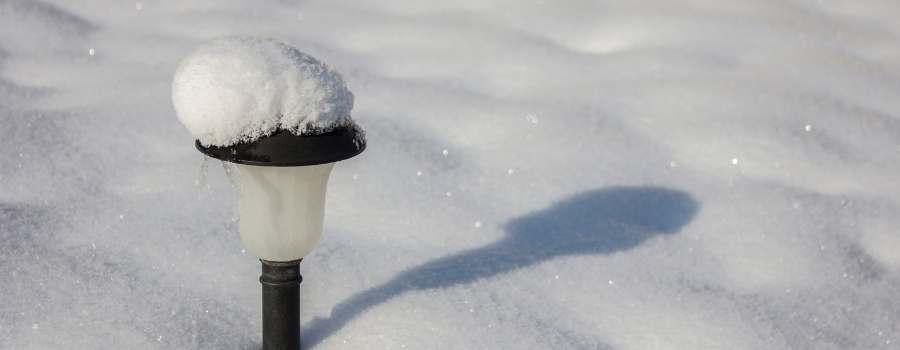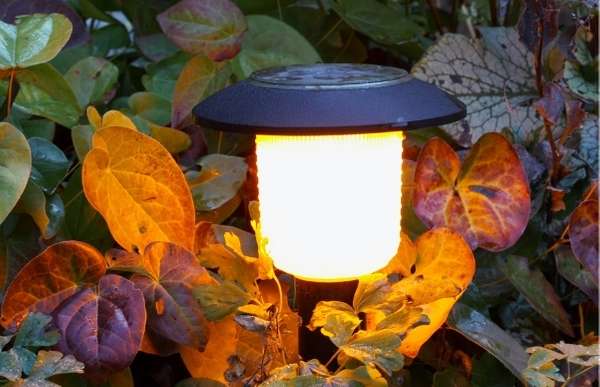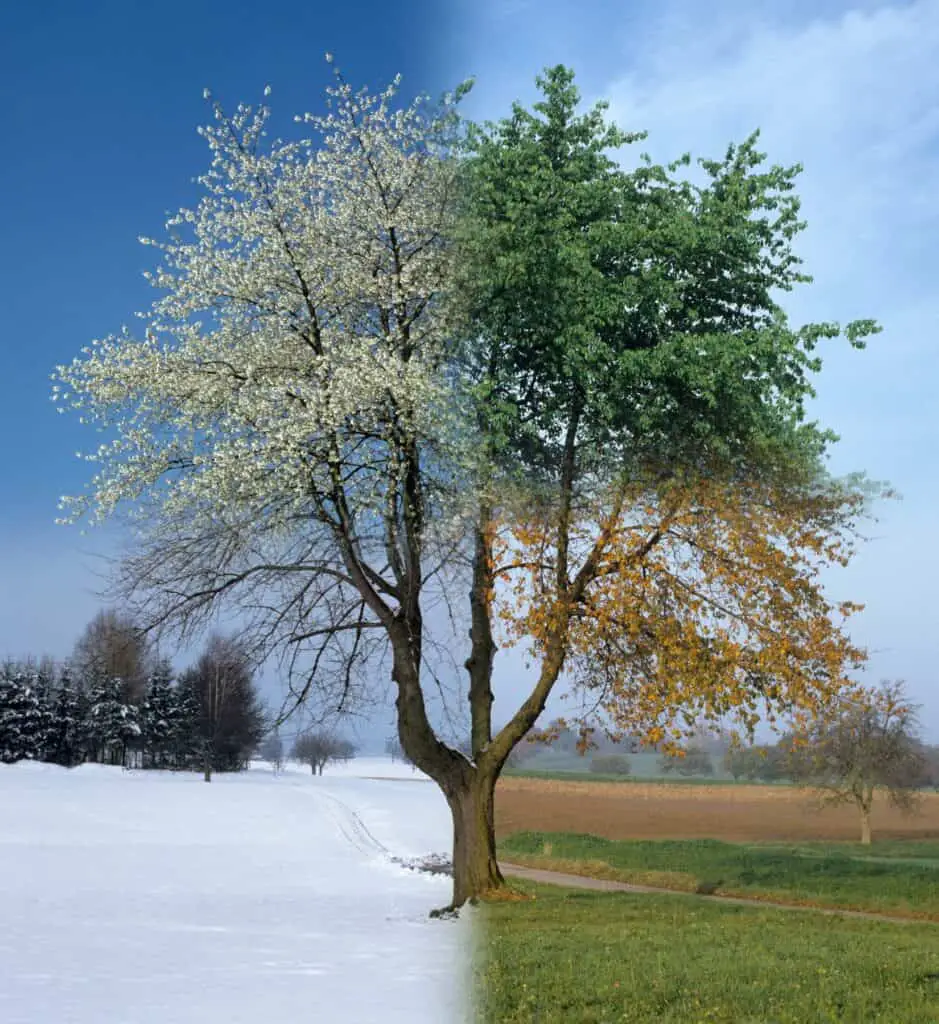
It seems like no matter the time of year winter always feels like it is just around the corner. The days are getting shorter, the air is starting to get crisp and cold, and soon enough many of use will be seeing snow.
While it can be tempting to pack up our solar lights for this season, there are many ways you can protect them in the long run so they’ll last until next year.
What To Do With Solar Lights In Winter
In general, if you winters are fairly mild then all you really need to do is position them to best take advantage of the shorter sunlight that’s available. For more harsh winters with a lot of ice and snow it may be best to store them until spring.
When it comes to solar lights in winter, there are a few things you can do to ensure that they continue to function optimally throughout the colder months. First, it’s important to note that solar lights rely on sunlight to charge their batteries, so you may notice a decrease in performance during the shorter days of winter.
To combat this, you can try moving your solar lights to a sunnier location, such as an area that receives more direct sunlight. Additionally, you can clean the solar panels on your lights to ensure that they are able to absorb as much sunlight as possible.
Another option is to switch to LED solar lights, as they tend to be more efficient and require less sunlight to function. You can also consider purchasing solar lights with larger batteries, which will allow them to store more energy and provide longer-lasting light during the winter months.
It’s also important to remember to bring your solar lights indoors during periods of extreme cold or snow, as this can damage the batteries and reduce their lifespan. Finally, if you live in an area with particularly harsh winters, you may want to consider removing your solar lights altogether and storing them indoors until the weather improves.
So that was the general answer…keep reading for 13 great tips with descriptions.
1.) Pick A Really Good Spot
Most issues that come during the wintertime that affect your solar light have to do with weather and the elements. While this feels unavoidable for your outside lights, it may not be the case.
Check your porch and yard to see if you can find a sweet spot that receives the best winter light while staying safe from the wind, rain, and snow.
2.) Keep An Eye On The Weather Reports
Your light will most likely be able to survive a drizzle…maybe even the entire winter. However, all winters are not the same and it might be that the winter where you live will not be harsh enough to have a negative effect on your outdoor lighting.
Be sure to pay attention to weather reports in your area and take note of times that may become particularly harsh. It is always best to be mindful of when long periods of rainfall, frost, snow, or other harsh conditions that could harm your lighting may occur. Preparation is key…your lighting will likely be just fine most winters, but there may be that particularly harsh day or two that could cause some serious damage to your outdoor solar lighting.
3.) Don’t Be Afraid To Uproot Your Solar Lighting
If your lighting looks like it’s going to bee sitting in a damp or frosty spot for a long period of time, don’t hesitate pulling them up and setting them in the garage or shed until the weather improves. Many solar lights have a spike on them and are staked into the dirt.
And don’t forget to to keep an eye on the solar panel itself. While most path style solar lights have a built in solar cell right on top of each light, some string lights…and even some path lights…are wired to a separate solar panel for greater flexibility on light placement. Since there is a wire from this panel to the lights, you want to make sure it doesn’t sit in water or get frozen to the ground.
4.) Ensure Your Solar Light Is Good Quality
You don’t have to break the bank to get yourself a good solar light. Even lights on the cheaper side can potentially survive winter, but there are some key things to keep in mind when purchasing your light.
Lithium Ion batteries are a key difference between a light that breaks, and a light that lasts. There are many lamps available, and the more you are willing to spend, the more likely you will get longer use from your light. While it is sometimes recommended to store your lights during winter, you can do a little research into lights that are better suited for harsher climates and roll the dice on leaving them out all year..honestly, most lights will do just fine in places with mild winters.

5.) Find The Best Solar Light To Fit Your Needs
Most lights don’t need to be active at all times, this can ensure your lamp survives winter. Some lights, such as security lights or specialized welcome lights, only need to operate for short periods of time. These lights will use less natural light and may be a better option for your home depending on what lighting setup you are looking for.
Knowing what your vision is for your backyard and path lighting can make a huge difference when it comes to finding your perfect lighting kit.
6.) Keep Your Solar Lights Away From Water
Even though most of your lighting will be made of plastic, there are still pieces of metal that can rust if they are exposed to water. Luckily, solar lighting is designed to be water tight so a little rain or snow won’t hurt them, but if they are sitting in water or blanketed in snow some water is going to seal in and rust.
This reaction can occur faster than you may think and once rust begins it can be very difficult to stop. It’s not just ugly to look at either, it can badly affect and even destroy your light permanently.
If you notice your lighting gets submerged in puddles every winter then you may want to rethink your placement or consider some drainage improvements to your landscaping.
7.) Check Which Areas Of Your Yard Get The Most Winter Sun
You might have the safest, warmest place set aside for your lights to sit for the whole winter, but this can also be a problem if the solar cell gets no sun at all.
Many experts recommend observing the suns path across your yard to see which area gets the most sun around mid-day…this means the photovoltaic cells (the little solar panels) on top of your solar lighting gets the most sun to keep the batteries charged.
Even in the dead of winter, when the days are shortest, if your lighting gets enough sunlight the batteries should charge enough to keep your yard lit well into the evening.
8.) Beware Of Rodents
Rodents have a habit of keeping their teeth clean and strong by chewing on anything they come across, including the wires on your outdoor solar lights. Even lights the are stored away for the winter could be prone to some rodent midnight snacking.
This is more common than you think, and can be a hassle for keeping your electrical supplies safe and in good working order. Ensure your storage area is rodent free, covered and sealed to keep your lights safe from pests. For extra protection you may want to wrap your lights in plastic before storing them…this will also help keep the dry.

9.) Don’t Waste The Batteries
One way the long winter can affect your solar lighting is if the battery is still on when kept in storage. You’d be surprised how easy it is to forget to check that the light is off before storing it.
Most solar lights will have an ‘on/off’ switch that you will want to make sure is set to “off” before storing. If your lighting has an easy access panel to get to the battery, you may want to pull it out and store it in a safe, easy to find place for spring.
10.) Make Sure Your Solar Lights Are Clean
If you find that your solar lighting isn’t as bright as it used to be you might want to check the lens to see if it has a layer of dirt and grime built up. It’s always a great idea to clean your lighting each spring since grime can cake on and become difficult to remove.
While you’re cleaning the lens, be sure to give a once over to the solar cell as well. As these becomes covered in dust, less sun can make it through making your lighting much less efficient.
11.) Make Sure Your Solar Lights Are Not Receiving Artificial Lights When It’s Dark
Solar lights have special cells to detect light…including artificial light, which alone will not be adequate to charge your lighting properly. If you’re not careful, this weak variety of light can lead to battery issues in the future and may be a problem for your light or lamp.
12.) Keep The Glass From Breaking
Your solar light’s lens will most likely be made of glass or a thin plastic, both of which can be quite fragile. Always ensure that your lamp is stored in an area safe from falling, or other objects falling onto it.
If you are leaving your lighting out all winter, be sure to keep snow from building up onto of your lights…snow might look light and fluffy, but it can get quite heavy, especially if it is a wet snow.
If you let your lights get completely covered over by snow, then you may forget exactly where they are and accidentally run a shovel or snow plow over them…even the most durable brand of solar lights isn’t going to survive that.
13.) It’s Okay To Leave Your Solar Lights Out Year ‘Round
Some winters are mild, and some lights are designed to last through strong winds, rain, and even moderate amounts of snow. If you do research on various brands of solar lighting you’re sure to find a kit that will hold up to the winter condition in your area…and if not, just get a good set of lights and bring them in when winter rears its ugly head.

Final Thoughts
Of course, it’s easy to leave solar lights out all year long in a place like North Dallas…our winters are mild (can you even really call them winters!?)
But having spent most of my life in Anchorage, Alaska I think it’s safe to say that anyone with solar lighting outside will want to bring it in after the snow starts to fly….and I’m sure other states with very harsh winters are in a similar boat.
But for the vast majority of people these 13 points are worth checking out…the cold won’t cause any rubber or plastic pieces to crack and the snow shouldn’t get deep enough to pack down and crush your lights…or, as in most spring thaws in Alaska, finding out that you had plowed right over them when clearing the driveway of snow!

